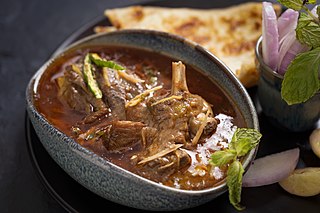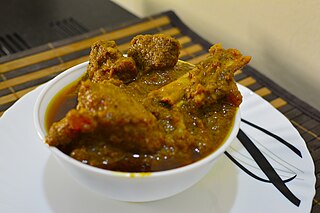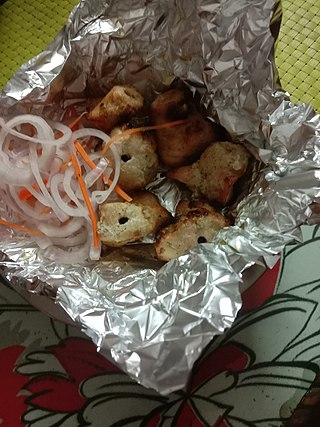
Kebab, kabob, kebap, or kabab (Kashmir) is roasted meat that originates from the Middle East. Many variants of the category are popular around the world, including the skewered shish kebab and the doner kebab with bread.

Awadh, known in British historical texts as Avadh or Oudh, is a historical region in northern India, now constituting the northeastern portion of Uttar Pradesh. It is roughly synonymous with the ancient Kosala region of Hindu, Buddhist, and Jain scriptures.

Pakistani cuisine can be characterized as a blend of regional cooking styles and flavours from across South, Central and Western Asia. Pakistani cuisine is influenced by Persian, Indian, and Arab cuisine. The cuisine of Pakistan also maintains certain Mughal influences within its recipes and cooking techniques. Pakistan's ethnic and cultural diversity, diverse climates, geographical environments, and availability of different produce lead to diverse regional cuisines.

Biryani is a mixed rice dish, mainly popular in South Asia. It is made with rice, some type of meat and spices. To cater to vegetarians, in some cases, it is prepared by substituting vegetables for the meat. Sometimes eggs and/or potatoes are also added.

Chelow kabab is an Iranian dish consisting of steamed rice and one of the many varieties of Iranian kebab. It is considered the national dish of Iran, and was probably created by the time of the Qajar dynasty.

Nihari is a stew originating in Lucknow, the capital of 18th-century Awadh under the Mughal Empire in the Indian subcontinent. It consists of slow-cooked meat, mainly a shank cut of beef, lamb and mutton, or goat meat, as well as chicken and bone marrow. It is flavoured with long pepper, a relative of black pepper. In Pakistan and Bangladesh, nihari is often served and consumed with naan.

Kofta is a family of meatball or meatloaf dishes found in Balkan, Middle Eastern, North African, South Caucasian, South Asian and Central Asian cuisines. In the simplest form, koftas consist of balls of minced meat – usually beef, chicken, pork, lamb or mutton, or a mixture – mixed with spices and sometimes other ingredients. The earliest known recipes are found in early Arab cookbooks and call for ground lamb.

Seekh kebab is a type of kebab, native to the Indian subcontinent, made with Indian spices, spiced minced or ground meat, usually lamb, beef, or chicken, formed into cylinders on skewers and grilled. It is typically cooked on a mangal or barbecue, or in a tandoor. Seekh kebabs are prepared in homes and restaurants throughout South Asia. It is a signature dish in Indian metro cities like Bhopal, Delhi, Hyderabad, and Lucknow, but they can be found all over India.

Shami kabab or shaami kabab is a local variety of kebab, originating from the Indian subcontinent. It is a popular dish in modern-day Indian, Pakistani and Bangladeshi cuisines. It is composed of a small patty of minced meat, generally beef, but occasionally lamb or mutton, with ground chickpeas, egg to hold it together, and spices. Shami kebab is eaten as a snack or an appetizer, and is served to guests especially in the regions of Dhaka, Deccan, Punjab, Kashmir, Uttar Pradesh and Sindh.

Shish kofta (Turkish) is a type of kebab-style kofta dish in Turkish cuisine.

Hyderabadi cuisine, also known as Deccani cuisine, is the native cooking style developed in the kitchens of the Muslim aristocrats of the erstwhile Hyderabad State, India. The haute cuisine of Hyderabad began to develop after the foundation of the Bahmani Sultanate, and the Qutb Shahi dynasty centered in the city of Hyderabad promoted the native cuisine along with their own. Hyderabadi cuisine had become a princely legacy of the Nizams of Hyderabad as it began to further develop under their patronage.

Mughlai cuisine consists of dishes developed or popularised in the early-modern Indo-Persian cultural centres of the Mughal Empire. It represents a combination of cuisine of the Indian subcontinent with the cooking styles and recipes of Central Asian and Islamic cuisine. Mughlai cuisine is strongly influenced by the Turkic cuisine of Central Asia, the region where the early Mughal emperors originally hailed from, and it has in turn strongly influenced the regional cuisines of Northern India, Pakistan and Bangladesh.
Awadhi cuisine is a cuisine native to the Awadh region in Northern India and Southern Nepal. The cooking patterns of Lucknow are similar to those of Central Asia, the Middle East, and Northern India and western India with the cuisine comprising both vegetarian and non-vegetarian dishes. The Awadh region has been influenced by Mughal cooking techniques, and the cuisine of Lucknow bears similarities to those of Central Asia, Kashmir, Punjab and Hyderabad. The city is also known for its Nawabi foods.

Khichra or Khichda is a variation of the dish Haleem, popular with Muslims of the Indian subcontinent. Khichra is cooked all year and particularly at the Ashura of Muharram. It is made using goat meat, beef, lentils and spices, slowly cooked to a thick paste. It is the meat-based variant of Khichdi, a rice dish from the Indian subcontinent. In Pakistan, beef Haleem and Khichra is sold as street food in most cities throughout the year.

Chapli kebab or chapli kabab is a Pashtun-style minced kebab, usually made from ground beef, mutton or chicken with various spices in the shape of a patty. The chapli kabab originates from Peshawar in Pakistan. The Peshawari chapli kabab is made with beef and is a popular street food throughout South Asia, including Pakistan, India, Afghanistan and Bangladesh.

Nargesi Kebab, Nargesi Kofta or Narges Shami Kebab is an Afghan, Indian, Pakistani, and Middle Eastern dish originating in Lucknow, Uttar Pradesh during the Mughal period and is a kind of kebab or kofta with a chicken egg in the middle. It is named after the Narcissus flower because kebabs look like the flower's petals when they are cut.

Mutton curry is a dish that is prepared from goat meat and vegetables. The dish is found in different variations across all states, countries and regions of the Indian subcontinent and the Caribbean.

Keema matar, also rendered Qeema matar, is a dish from the Indian subcontinent associated with the Mughals. The term is derived from Chaghatai Turkic قیمه which is cognate with Turkish kıyma.

Reshmi kabab is a famous non-vegetarian chicken kebab commonly eaten in India and Pakistan.

















